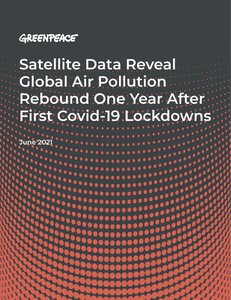Jakarta – Levels of toxic NO2 air pollution have rebounded in cities around the world one year after initial Covid-19 lockdowns went into effect, a new report from Greenpeace Southeast Asia finds. [1]
“This research shows that as long as our energy and transport systems are powered by fossil fuels, air pollution will remain a major public health crisis. During the first half of 2020, cleaner air was a temporary byproduct of lockdowns in many areas, but now we must implement real, long-term solutions that enable us to breathe safe air regardless of how much we move around our cities. Wind and solar energy and clean transport solutions are often more cost-effective than fossil fuel alternatives — but we need governments to adopt them,” said Dr. Aidan Farrow, an air pollution scientist at Greenpeace International Research Laboratories.
Key report findings, based on analysis of satellite data:
- In many locations around the world, NO2 air pollution was substantially lower during initial Covid lockdowns in early 2020 than during previous years. [2]
- One year after the first Covid lockdowns went into effect, NO2 pollution had rebounded in all areas studied. This result was supported even after weather conditions were taken into account.
- Gauteng province, South Africa, where Johannesburg is located, saw the most dramatic increase in air pollution relative to pre-Covid conditions. NO2 pollution fell by approximately 30% in April 2020, but pollution during the same period in 2021 exceeded pre-pandemic levels by 47%.
- Despite major decreases in air pollution in early 2020, in a number of cities, including Bangkok and Jakarta, NO2 had returned to pre-Covid levels one year after initial lockdowns.
- Although all cities saw NO2 pollution rebounds in April 2021, in some cities, including Los Angeles and Wuhan, NO2 pollution remained below pre-COVID levels.
NO2 is released into the air when fuel is burned, including in vehicles, power generation, and industry. NO2 emissions can be reduced via increased use of renewable energy sources, such as wind and solar, and investment in public transport systems and supporting infrastructure.
“As they pursue economic recovery amid the pandemic, governments have a major opportunity to invest in clean energy sources, such as wind and solar, and to fund clean and accessible public transport. At the same time, there are some norms from lockdown, such as reduced flight travel, increased cycling and remote work, that would further reduce air pollution concentrations if continued after Covid,” said Bondan Andriyanu, campaigner at Greenpeace Indonesia.
Notes
[1] Researchers analysed ground-level measurements of NO2 and fine particulate matter (PM2.5) as well as readings of NO2 atmospheric column amount measured by the Tropomi sensor on board the Sentinel-5P satellite.
[2] In this report, pre-Covid air pollution levels are calculated based on the average of NO2 concentrations in 2018 and 2019, the first two years that Tropomi NO2 data was available.
Media Contacts
Erin Newport, International Communications Officer, Greenpeace East Asia
E: [email protected]; M: +886 958 026 791
Greenpeace International Press Desk, [email protected], +31 (0) 20 718 2470 (available 24 hours)

